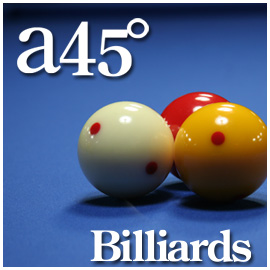
If a player knocks the 8 ball into a pocket before pocketing all of their other balls, they lose automatically. Each player continues taking turns shooting. If the first player misses, it's the next player's turn. They can then shoot either a solid or stripe to select which set of balls they want to shoot, and the opponent takes the other set after they’ve legally pocketed a ball. If the breaking player pockets a ball by knocking it into the one of the six holes on the table, they continue shooting. The starting player breaks the balls by hitting the white ball, called the cue ball, from behind the headstring, which is the line created by the second set of diamonds on the opposite side. Then, lift the rack up without disturbing the balls.

Place the triangle at one end of the table and line up the 1 ball on the foot spot, which is where the second set of dots, called diamonds, on the longer sides of the table line up in the middle. The order of the other balls should be random. Put the yellow 1 ball in front, the 8 ball behind it in the middle, and then put one solid on a back corner and one stripe on the other back corner. To set up the game, fill the triangle, called a rack, with all 15 of the numbered balls, called object balls. The aim of the game is to sink all of your balls, either stripes or solids, and then sink the 8 ball before your opponent. Pool is a 2-player game that's played on a pool table using pool balls and cues. During your practice strokes, your eyes should switch from the contact point on the cue ball to the point you're aiming for on the object ball.Your feet should be a little wider than shoulder-width apart and at a 45-degree angle.Experiment with a few to see what yields the best results. Some will prefer to rest the stick on their index finger while others may rest the cue in between their fingers in a flatter style.This is a good, basic way to put your hand in position because you have total control of the stick. For a good hand position, try putting your index finger on the top of the stick (curving it) and put your thumb at the bottom of the stick.If you are right-handed, hold the base of the stick with your right hand and rest the narrow end on your left. Each person has a different preferred hand position. If a player makes the 8 ball in a pocket but then scratches, they lose.If a player scratches when shooting for the 8 ball, their turn ends and it is their opponent's turn.If a player inadvertently sinks the 8 ball before all their other balls are in, they lose.If a player inadvertently sinks a ball of the other player's, it counts to the other player's benefit.The first player to sink the 8 ball is the winner. Both players sink all their pool balls into the pockets until just the 8 ball is left.If the player makes a ball of each variation, they may choose which one they prefer.The other player receives the variation they did not claim. If he or she makes a ball into a pocket, he or she claims that type (solid or stripes) for the duration of the game and shoots again. Different people have different preferences for the set up, but make sure the 8-ball is in the middle. Use the triangle to " rack up" the 15 pool balls.Quite clearly, knowing the rules is the only way to win.

The cue ball is always solid white, a bit heavier, and should be the only ball directly hit during the game.

If you are playing on a smaller table, you may want a shorter cue. For example, a 7-foot table is 7 feet (2.1 m) long and 3.5 feet (1.1 m) wide. The Billiard Congress of America defines a "regulation" pool table as any table that is twice as long as it is wide.

There are three standard sizes to a pool table: 7, 8, and 9 feet (2.7 m).Tips vary from soft to hard, though inexperienced pool players are best served with a medium to medium-soft tip. The tip is the most important part of a cue (it's on the narrow end you'll be hitting with). Most sticks are 58 inches (147 cm) in length, but shorter and longer ones are available. There are generally three things you'll be using: a cue, table, and pool balls.


 0 kommentar(er)
0 kommentar(er)
